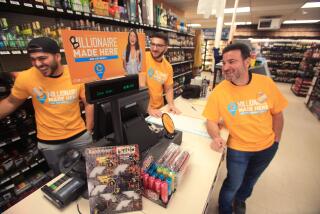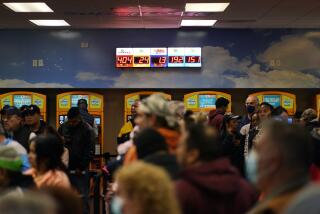Hey, big spinner, penny for your slots
- Share via
THE more you play slot machines, the more you will lose. It’s common wisdom, but still it bears repeating.
I wasn’t three minutes into one of the slot tournaments that can be found throughout this city when I swear that the woman competing next to me had broken out in a sweat. Furiously pounding the “Spin Reels” button, hunched over the screen and chanting, “Come on, big numbers! Big numbers!”
I was doing pretty much the same, except I was embarrassed enough to keep my praying silent.
So let’s get right to the point about America’s favorite gambling devices. Slots should be played only for fun and entertainment -- and absolutely never with any expectation of winning. Anyone who tells you he has a system to beat the slots is on tilt. There are no systems. There is no such thing as a hot or cold machine. And there isn’t a single machine among the 800,000 in the U.S. that is “due” to pay out in the next five minutes -- or even the next five days. And when one does erupt, it might do it again two minutes later. Or maybe not for two more years.
Which makes the notion of a slot machine tournament absurd but clearly illustrative. To stand in front of modified slot machines that accept no money and for a full 20 minutes furiously pound that spin button and hope that at the finish bell one has racked up the greatest number of jackpot credits takes no skill, no decisions, no strategy. Just heavy shoulder-and-wrist action.
The steely, unforgiving heart at the center of each machine is a micro-processor called an RNG, a “random number generator.” It’s precisely programmed to determine how much of the gross intake the machine will return to the players and what the frequency of those payoffs will be. Even while the machine isn’t in play, it’s coldly clicking through an astonishing 200 million numerical combinations per second. The instant you pull the handle or push the button on the machine, your fate is sealed.
Forget about luck or even about loose gears in the reels. The mechanical reels or video readouts on the machine are but visual presentations of the internal computer’s predetermined outcome of the spin.
So the only real choice is how you most prefer to lose your money.
At the swank Mandalay Bay, I found a variety of machines that fell roughly into two categories.
There were tickle-and-trickle penny machines, including the Munsters, Rakin’ It In, Free Spin Mania, Shake Your Booty and Reel ‘Em In. I chose a traditional three-reel spinner, the classic Double Diamond, 25 cents a pull, up to three coins at a time and with meaty jackpots of $2,000 or more. Twenty-five bucks and about 15 minutes later, I had hit exactly zip.
There are two basic categories of slots: machines that pay off more or less frequently. And remember: A payoff doesn’t mean coming out ahead. “Winning” often means less than your total bet.
Low-hit frequency machines -- the classic one-arm bandits with three reels and a single payout line -- are the ones that deliver the biggest jackpots, sometimes “life-changing” amounts from thousands to millions of dollars if they are tied into a large, mounting “progressive” pool of other machines.
By contrast, I wheeled over to the Orleans casino. Like most lower-end “locals” joints, the Orleans has slots on which the payback tends to run a tad higher than in the Strip’s mega-tourist traps.
I swallowed all pride and went right for the bottom end, taking a seat at what must be the biggest slot machine in the world. The multiplayer circular 1-cent Wheel of Fortune contraption sits in the middle of the casino floor like a just-landed UFO.
Seating nine players around its 12-foot diameter, it towers about 10 feet in the air. At its center is a mammoth wheel of fortune. I took seat No. 5. I could have played it for a mere penny but wouldn’t have qualified for the $1,813,415.65 jackpot. The retired schoolteacher next to me explained that I could play at $4 a spin, but 80 cents would qualify me for any big handout.
Then she cut her tutorial short when she saw three images of Pat Sajak and Vanna White align, and the wheel began to spin in front of us, eventually stopping on 700. I was impressed -- until I found that it was 700 credits, only $7. I shelled out 20 bucks. Then another 20. And a few minutes later, 10 more. When I was down to my last $1.70 of credits, I hit the wheel like the teacher. It kicked back $50. A gigantic win, I thought, having lost a total of less than $20. Clearly my life hadn’t changed.
The higher-frequency payout machines, like Vanna’s, tickle and trickle. With complicated video screens, sometimes dozens of pay lines, armies full of animated bunnies and carrots, dancing doughnuts and jumping fish, they joyously announce you’re a “winner” on an alarmingly frequent basis. And although they’re presented as ridiculously cheap penny slots, to get full payoffs, you have to play 200, 300, sometimes 450 credits per spin. That’s between $2 and $4.50 (though you can play up to $12 a pull). And if you pull 600 times an hour -- which is the estimated amount of play that these machines can process -- that means you’re cycling through as much as $2,700 per hour.
As a rule, it’s also generally better to play higher- rather than lower-denomination machines. Casino Player magazine, which tracks slot payoffs, calculates that the return on the average $1 machine in Vegas is 96% to 98%, whereas 25-cent machines are programmed between 93% and 95%, and the high-hit-frequency penny grubbers come in closer to 90%.
To put those percentages into context: Playing a lowly 25-cent machine with a 90% payback, a player’s estimated loss will be $12 an hour. Bump that play up to $3 a spin, and you’re calculated to lose $144 every hour. Now you know why fish are such a common image on these machines.
I made it back to Main Street Station just in time for my 4 p.m. slot tournament playoff. I was up against 15 determined competitors. As soon as the timer went off, I smashed away at that spin button so hard I could feel the impact in my bones. My shame had evaporated; I wanted to crush my opponents.
I finished fourth. First prize was $180. Second place got $90. Third place gets $50. I got a small shoeshine kit. Once again, a winner.


